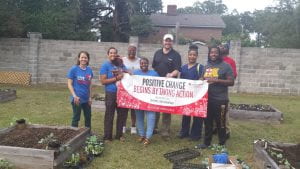Overview
Climate Resiliency, defined as the power for communities to understand stresses that occur as a result of a climate change event, and is how a plan is cultivated to be better prepared, to adapt, reorganize, and increase sustainability for the future.
In this activity, small groups will work together to delve deeper, research and brainstorm solutions that help prepare for resiliency in an area they are interested in. Each small group will create and present an Action Plan, based on their theme of choice:
- Community Climate Resiliency Action Plan
- Food System Action Plan
- Invasive Species Action Plan
Skill Level
Intermediate/Advanced
Learner Outcomes, Youth will:
- Identify and predict the short and long-term problems that affect one or more systems, that are a result of significant changes of climate and global warming: food system, environment, eco-systems, infrastructure, public health, and the health and well-being of all living things.
- Recognize factors that contribute to the problems and brainstorm for solutions.
- Compare and contrast existing community action plans, to be used as a model for future planning.
- Create an Action Plan resiliency with realistic goals and identify possible obstacles and solutions that may get in the way of achieving objectives.
- Identify valuable community partners who can contribute to and help implement an Action Plan for resiliency.
Education Standards
- MS-ETS1, MS-ETS1-2, HS-ETS1-2. Define the criteria and constraints of a design problem to ensure a successful solution. Evaluate competing design solutions using a systematic process.
- MS-ETS1-3, HS-ETS1-3. Analyze and interpret data to identify the solution to better meet the criteria for success. Evaluate a solution to a complex real-world problem including safety, as well as possible social, cultural, and environmental impacts.
- MS-ESS3-2, HS-ESS3-1. Analyze and interpret data on natural hazards to forecast future catastrophic events and mitigate their effects. Construct an explanation based on evidence for how the availability of natural resources, occurrence of natural hazards, and changes in climate have influenced human activity.
- HS-ESS3-5. Analyze data and the results from global climate models to make an evidence-based forecast future impacts to Earth systems.
Success Indicators
Youth identify and provide solutions to real world problems that affect communities.
Life Skills
Resiliency, goal setting, problem solving, service learning, responsibility, teamwork
Time Needed
One hour for introductory activity and research, Group Work on Action Projects will vary.
Materials List
- Devices with Internet access to watch videos and read online resources for research.
- Devices to develop digital presentation, and/ or materials to create visual aids: poster board, pens and colored markers.
- Three pages of flip chart paper, wall or white board for brainstorming ideas and enough post it note pads and pens for each person. On each page of flip chart paper or in columns on a white board, write the three opening questions so each question has its own space.
- Online resources, based on the theme that each small group will choose for their Action Project.
Youth Handout
I. Community Climate Resiliency Action Plan
- NYS Dept. of Environmental Conservation, Adaptation to Climate Change https://www.dec.ny.gov/energy/100236.html
- U.S. Climate Resilience Toolkit: Meet the Challenges of a Changing Climate and Building Resilience in the Northeast
II. Food System Action Plan
- Food Span: Develop a Food Citizen Action Plan
III. Invasive Species Action Plan
Action Project Best Practices Resources and Guidance
- Earth Force Process
- Southeast Michigan Stewardship Coalition: This group uses a place-based education approach, and typically starts with an “essential question” (ex: a youth-led research question) in a particular area of interest.
Space
Appropriate space and technology and internet access and place for groups to plan and develop presentations or posters or present the project.
Suggested Group Size
12-15 or more
Introduction
Actions to address climate change may be a result of destruction and displacement from unexpected extreme weather events, impacts from invasive species and issues that arise in our food system. Communities are taking action to plan for such future impacts and catastrophic events. This activity will build on the Introduction to Climate Resiliency in Unit 2, where your group learned how local and global communities are preparing for the future.
Climate Resiliency, defined as the power for communities to understand stresses that occur as a result of a climate change event, and is how a plan is cultivated to be better prepared, to adapt, reorganize, and increase sustainability for the future.
In this activity, small groups or 3-5 will work together to delve deeper, research and brainstorm solutions that help prepare for resiliency in an area they are interested in. Each small group will create and present an Action Plan, based on their theme of choice: Community Climate Resiliency Action Plan, Food System Action Plan, Invasive Species Action Plan.
Opening Questions
Ask opening questions to spark interest in which theme participants are interested in:
- Have you or someone you know been affected by extreme weather-related events (flooding, hurricanes, etc.) and how, if at all were you or they prepared for it?
- How do you see changes in climate change problems with our food system?
- Can you name an invasive plant or insect that is new to where you live? How do you think they got here?
Background Information
Before the Activity
Prepare materials and handouts, provide or suggest devices (mobile phone, tablet, laptop) with Internet access, video capability. If using digital presentations or online collaboration, access to applications, PowerPoint or other presentation software. Participants may provide their own or use a computer lab at a school or library. Review introductory videos and Action Project Best Practices resources.
Let’s Do It!
Part A
Steps 1-5: Introduce and Launch the Activity
#1 Step One
Introduce the activity by asking participants to recall the activity in Unit 2 Introduction to Climate Resiliency, where they discovered how people in communities and around the world are addressing climate change issues through making residency plans for the future. Have the group discuss what they learned from this earlier activity and who or what actions may have inspired them to do more.
Optional: have participants write their recalled responses on sticky notes and post them in the room next to the flip chart paper, wall or white board you will be using in Step 2, brainstorming ideas.
Next: Explain that you will be working in small groups to create an Action Project, very much like those resiliency projects you learned about in Unit 2. If needed, explain what an Action Project is. Use the Action Project Best Practices in the Materials List for guidance. Before breaking down into small groups, explain that you will be brainstorming ideas for the small group activity, to see what themes of the Action Plans will be about.
#2 Step Two
Ask the opening questions, one at a time. Each time you ask the question, have students transcribe their answers onto sticky notes, and have them take turns bringing the sticky notes up to the corresponding white board or flip chart after you ask each question. For question #1 they can reference one of the videos they watched from Unit 2 if they do not know of anyone personally.
Note: If your group did the optional recall activity in Step 1a, encourage them to move those sticky notes over to the new corresponding board or flip chart.
#3 Step Three
Ask for volunteers to come up and read the sticky notes, once they are all posted.
#4 Step Four
After step 3, ask the group to consider which of these 3 questions they feel most passionate about, and which theme they would like to develop as an Action Plan.
#5 Step Five
Create small groups of 3-5 based on theme choices, by either having participants raise their hands to choose a topic: 1. Extreme Weather and Community Resilience 2. Food Systems or 3. Invasive Species.
Part B
Steps 1-3: Group Work (an adult leader should help guide the small groups in this process)
#1 Step One
Break down into small groups and have each group pick an activity from a relevant resource listed below, and explain how they can use this and other research to plan their Action Projects.
Community Climate Resiliency Action Plans
- Community Risk and Resiliency Act (CRRA): Mainstreaming Consideration of Climate Change
- U.S. Climate Resilience Toolkit Meet the Challenges of a Changing Climate: https://toolkit.climate.gov
- Building Resilience in the Northeast: https://toolkit.climate.gov/regions/northeast/building-resilience-northeast
Food System Action Plan: Food Spans
Develop a Food Citizen Action Plan: http://www.foodspanlearning.org/lesson-plans/final-project/
Invasive Species Action Plans: DEC Invasive Species Education & Outreach Initiatives
https://www.dec.ny.gov/animals/114620.html
#2 Step Two
Hand out the Action Project Worksheet and web links for groups to research and/or do pre-work activities.
#3 Step Three
Sharing (see below)
Talk It Over
Share
Following the Action Project Worksheet each group will create a presentation, either digitally or using visual aids. Groups will take turns sharing their Action Projects.
Reflect
What did you learn about preparing for extreme weather-related and catastrophic events? How can we keep our food system intact when climate change causes issues? Although we cannot control weather-related issues that help introduce invasive species, what can we do to control invasive plants and insects to be sure their spread does not take over the environment?
Apply
What actions will you take to resolve or adapt to climate change problems in the future, as far as our food system, invasive species, and extreme weather?
References
- Community Risk and Resiliency Act (CRRA): Mainstreaming Consideration of Climate Change
- Invasive Species Education & Outreach Initiatives
Learn More
Action Project Resources
- Earth Force Process
- Southeast Michigan Stewardship Coalition: This group uses a place-based education approach, and typically starts with an “essential question” (ex: youth-led research question) in a particular area of interest.
Climate Change Resources
- Climate Smart Communities program
- Cornell University Northeast Regional Climate Center
- Cornell University Sustainable Campus Climate Resiliency
- National Wildlife Federation, Climate-Smart Communities
- New York Invasive Species Research Institute
- NYS Dept. of Environmental Conservation, Adaptation to Climate Change https://www.dec.ny.gov/energy/100236.html
- Food Span: Lessons of our Food System, includes a final project where students develop a Food Citizen Action Plan
- Responding to Climate Change in New York State (ClimAID)
- Our Climate Our Future: find stories about how youth across the country have been affected by climate change and climate solutions made by and for young people.
- The Alliance for Climate Education: covers the science of climate change and how youth can take action.
- U.S. Climate Resilience Toolkit: Meet the Challenges of a Changing Climate; Building Resilience in the Northeast
- W!ld Center Youth Climate Summit: Offers an annual Youth Climate Summit for local high school and higher education students.


